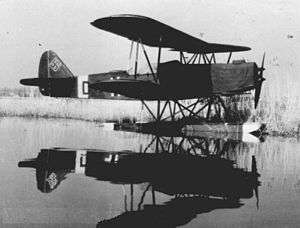Heinkel He 42
| He 42 | |
|---|---|
 | |
| A He 42 seaplane used for schooling on the board of the Black Sea, in 1942 | |
| Role | Maritime trainer |
| Manufacturer | Heinkel |
| First flight | 1929 |
| Primary user | Luftwaffe |
The Heinkel HD 42 50, later designated the Heinkel He 42 was a German two-seat biplane seaplane originally designed for the Deutsche Verkehrsfliegerschule, and later built for the German Luftwaffe. The aircraft was used until the end of World War II as a trainer for maritime pilots.
Design and development
In 1929, Heinkel developed a biplane, the HD 42, for use with the covert military-training organization Deutsche Verkehrsfliegerschule (DVS). Its fuselage was constructed out of a welded steel tube truss and had a rectangular cross-section with a rounded top. The engine covers were made out of light-weight metal, while the rest of the fuselage was covered in fabric. The aircraft was equipped with floats.
The HD 42 model received good feedback from the Swedish Navy, who had purchased the aircraft, as well as from the famous pilot Gunther Plüschow (who was the first airman to fly over the Patagonian mountains of Chile and Argentina at Tierra del Fuego). The prototype was equipped with a BMW Va engine, but the later versions came with a Junkers L5G engine.
Ten aircraft had been manufactured by 1932, when a new version, the He 42C was rolled out. Series production began with the He 42D model (14 manufactured) which were intended for the German Air Force, which at the time was illegal. A further 189 He 42Es were built in 1934 and these aircraft were used by various flying schools until the end of World War II
Variants
- HD 42
- Prototype aircraft
- He 42C
- He 42D
- First series produced model, 14 built
- He 42E
- Second series produced model, 189 built
Operators
Specifications (He 42)
General characteristics
- Crew: 2
- Length: 10.5 m (34.4 ft)
- Wingspan: 14 m/13 m (46 ft/43 ft)
- Height: 4.5 m (14.76 ft)
- Wing area: 56.03 m² (603.10 ft²)
- Empty weight: 1,550 kg (3,417 lb)
- Loaded weight: 2,150 kg (4,740 lb)
- Powerplant: 1 × Junkers L5G, 221 kW (330 PS, 296 hp)
Performance
- Maximum speed: 185 km/h (115 mph)
- Cruise speed: 160 km/h (99 mph)
- Range: 800 km (497 mi)
- Service ceiling: 3,700 m (12,139 ft)
See also
| Wikimedia Commons has media related to Heinkel He 42. |
- Related lists